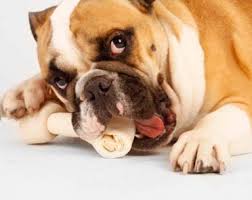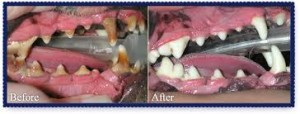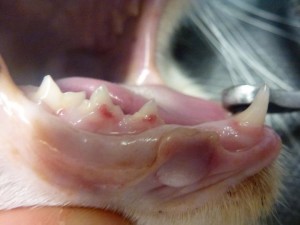Does your dog or cat:
– Have bad breath?
– Have loose teeth or teeth that are discolored or covered with tartar?
– Shy away when you touch the mouth area?
– Drool or drop food from the mouth?
– Bleed from the mouth?
– Have a decreased appetite or sudden weight loss?
Early veterinary examination is important. Think of it this way; the tartar on your pet’s teeth is bacteria. Every time your pet swallows; that bacteria is going into his/her bloodstream. That bacteria filled blood is traveling through all of your pets organs.
Although brushing your pet’s teeth regularly is recommended, you are not able to clean beneath the gum line to prevent periodontal disease. Therefore, it is important to get your pet in for a professional dental cleaning when you see a combination of the signs listed above.
What is a professional cleaning involve you ask?
Your pet gets dropped off with us in the morning and gets a full exam by the veterinarian. We use general anesthetic for the full dental procedure, which means we keep your pet until 3:00pm-5:00pm for observation while they recover from anesthesia.
The cleaning includes a thorough oral examination, scaling and polishing. Abnormalities found are recorded on a dental chart. Dental radiographs are required to correctly diagnose and assist in treatment of patients with extensive disease, and sometimes teeth are extracted if need be.
Fear of general anesthesia is a natural concern voiced by many owners when a dental procedure is recommended. However, the risk of chronic oral infection is far greater than the risk of an anesthetic complication.
My pet doesn’t seem to be in pain:
Most pets with painful dental problems do not show clinical signs that are obvious to the owner, but this does not mean that they are not feeling pain. In the wild, animals tend to hide signs of illness or weakness – dogs and cats posses these instincts.
Usually the pain develops over time, being that dental conditions are more common in older pets; the behavior that the owner interprets as “acting grumpy” may be the result of dental pain. Owners often observe that their pet “is a puppy/kitten again” following dental treatment.
Brushing your pet’s teeth as regularly as possible is the best way to promote a healthy mouth.
To introduce brushing to your pet, use the following steps:
1. Let your pet lick the pet tooth paste off your finger-do this for about a month. NO HUMAN TOOTH PASTE!
2. Now your pet looks forward to the tasty tooth paste treat. The next step is to rub your tooth paste covered finger on your pet’s gums and teeth-ONLY THE OUTSIDE SURFACES, YOUR PET’S MOUTH SHOULD STAY SHUT. Do this for another month.
3. Now your pet looks forward to his/her nightly gum massage. The last step is to introduce a pet toothbrush or kids toothbrush. Use in place of your finger and repeat step 2. It is important to go slow and take these steps because if your pet does not enjoy the brushing it becomes very difficult, even impossible, to do.
Chewing is a good way to prevent dental disease!
Rawhide products and chew treats can be helpful if chewed daily. Some rawhide chews and biscuits contain an anti-tartar ingredient. Palatability is important – chewing every day is the ideal. For rawhides- give them to your pet for ~15 minutes and take it away-  once the rawhide is soft it’s no longer doing any good. You can replace it with a new one/dry one and give them another ~15 minutes (amount of time depends on the dog)
once the rawhide is soft it’s no longer doing any good. You can replace it with a new one/dry one and give them another ~15 minutes (amount of time depends on the dog)
We do not recommend cow hooves, dried natural bones or hard nylon products because they are too hard and do not mimic the effect of a dog tearing meat off a carcass. These hard products are associated with broken teeth or damaged gums.
Pet dogs should be monitored while chewing a chew treat or toy, as they may swallow large pieces, leading to a variety of digestive system disorders.
Many cats get painful lesions at the gum line that invade the teeth. The lesions are referred to as feline odontoclastic resorptive lesions (FORLs). Recent research indicates that in cats over 5 years of age there is a 72% chance he or she may have a FORL.
Annual exams by your pet’s veterinarian is the best way to monitor their dental health. Regular home dental care (brushing & chewing) is the easiest and cheapest method of dental disease prevention. If your pet is experiencing any pain in the face/mouth, appetite changes or having odorous breath, an appointment with your veterinarian is always recommended.

